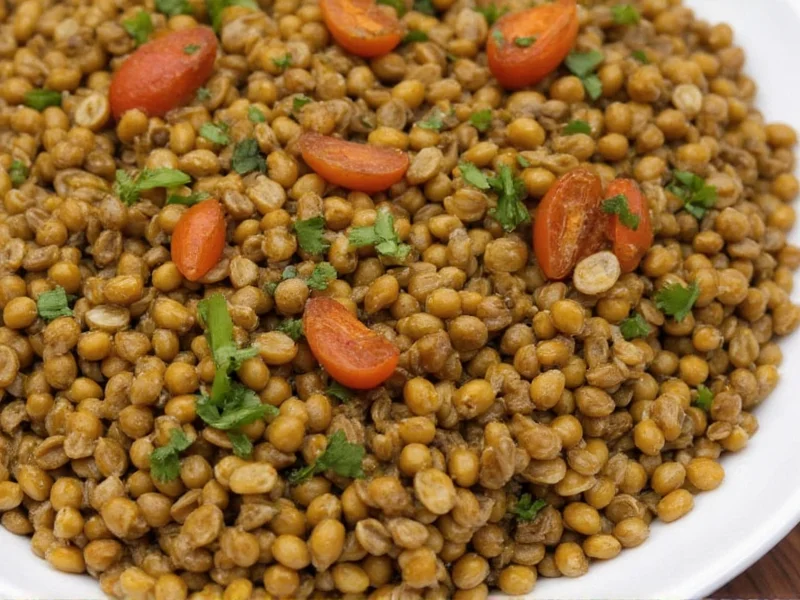Lentils represent one of the earliest domesticated crops, with archaeological evidence dating back 8,000-11,000 years. These versatile legumes have sustained civilizations across continents while providing exceptional nutritional value. Understanding the different types of lentils and their unique properties can transform your cooking and improve your dietary habits significantly.
Types of Lentils and Their Culinary Applications
Not all lentils behave the same in cooking. Each variety offers distinct textures, cooking times, and flavor profiles that determine their best culinary uses. Knowing these differences helps you select the right lentil for your specific recipe.
| Type of Lentil | Color | Cooking Time | Texture After Cooking | Best Uses |
|---|---|---|---|---|
| Green Lentils | Light to dark green | 20-30 minutes | Firm, hold shape well | Salads, side dishes, casseroles |
| French (Puy) Lentils | Dark green-gray | 25-30 minutes | Firmest texture, peppery flavor | Salads, gourmet dishes |
| Brown Lentils | Olive brown | 20-25 minutes | Slightly softer than green | Everyday cooking, soups, stews |
| Red/Yellow Lentils | Orange to yellow | 15-20 minutes | Soft, mushy when cooked | Dals, curries, purees, baby food |
| Black (Beluga) Lentils | Jet black | 25-30 minutes | Firm, caviar-like appearance | Salads, side dishes, gourmet presentations |
Nutritional Profile and Health Benefits
Lentils provide exceptional nutritional value with minimal calories. A single cooked cup (198g) of lentils contains approximately:
- 230 calories
- 18g of plant-based protein (35% of daily value)
- 15g of dietary fiber (53% of daily value)
- 6.6mg of iron (37% of daily value)
- 358mcg of folate (90% of daily value)
- Significant amounts of manganese, phosphorus, copper, and potassium
Research shows regular consumption of lentils supports cardiovascular health by reducing LDL cholesterol levels. Their high fiber content promotes digestive health and creates a sustained feeling of fullness, making them valuable for weight management. The complex carbohydrates in lentils provide steady energy release without blood sugar spikes, benefiting those managing diabetes.
Unlike many protein sources, lentils contain virtually no fat and no cholesterol. Their impressive protein-to-calorie ratio makes them an excellent choice for vegetarians, vegans, and anyone seeking to reduce meat consumption without sacrificing protein intake.
Proper Preparation and Cooking Techniques
Mastering how to cook lentils properly ensures optimal texture and flavor. Unlike beans, most lentils don't require soaking, though sorting and rinsing remains essential.
Follow these steps for perfect lentils every time:
- Sort through lentils to remove any small stones or debris
- Rinse thoroughly in a fine-mesh strainer under cold water
- Use 3 cups liquid (water or broth) per 1 cup lentils
- Add aromatics like garlic, onions, or bay leaves for flavor
- Bring to a boil, then reduce to a gentle simmer
- Cook uncovered until tender but not mushy
- Drain any excess liquid after cooking
Acidic ingredients like tomatoes or vinegar can toughen lentils and increase cooking time, so add these toward the end of cooking. For soups and stews where lentils should break down, add acidic components at the beginning.
Storage Methods for Maximum Freshness
Proper storage preserves lentils' quality and extends their shelf life significantly. Dry lentils stored correctly maintain nutritional value for 1-2 years.
For dry lentils:
- Store in airtight containers away from light and moisture
- Keep in a cool, dark pantry location
- Consider adding oxygen absorbers for long-term storage
For cooked lentils:
- Refrigerate in airtight containers for 5-7 days
- Freeze in portion-sized containers for up to 6 months
- Spread cooled cooked lentils on a baking sheet before freezing to prevent clumping
Culinary Applications Across Global Cuisines
Lentils feature prominently in traditional dishes worldwide. Understanding these cultural applications provides inspiration for incorporating lentils into your regular cooking rotation.
Indian cuisine relies heavily on red and yellow lentils for dals, with regional variations in spice blends and preparation methods. Middle Eastern cuisine features lentils in soups like shorbat adas and salads such as mujadara (lentils with rice and caramelized onions). Mediterranean cooking uses green and brown lentils in hearty stews and salads. French cuisine showcases Puy lentils in the classic salad Puy lentils with lardons and mustard vinaigrette.
For home cooks exploring how to use lentils creatively, consider these applications:
- Replace half the ground meat in burgers or meatloaf with cooked lentils
- Use pureed cooked lentils as a binder in vegetarian patties
- Add cooked lentils to soups for extra protein and texture
- Create lentil-based "taco meat" for plant-forward Mexican dishes
- Make lentil flour for gluten-free baking or flatbreads
Lentils in a Balanced Diet
When comparing lentils vs beans nutritional content, lentils generally cook faster and contain slightly more folate and iron. Both provide excellent plant-based protein, but lentils offer greater convenience for weeknight meals due to their shorter cooking time.
Nutritionists often recommend including lentils in diets for specific health goals:
- For heart health: The soluble fiber in lentils helps reduce LDL cholesterol
- For weight management: High protein and fiber content creates lasting fullness
- For digestive health: Both soluble and insoluble fiber support gut microbiome
- For pregnancy: Exceptional folate content supports fetal development
- For athletes: Complete amino acid profile supports muscle recovery
When incorporating lentils into your diet, start with modest portions to allow your digestive system to adjust to the increased fiber. Gradually increase consumption while drinking adequate water to minimize potential digestive discomfort.











 浙公网安备
33010002000092号
浙公网安备
33010002000092号 浙B2-20120091-4
浙B2-20120091-4